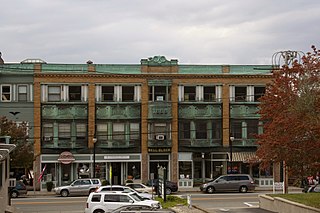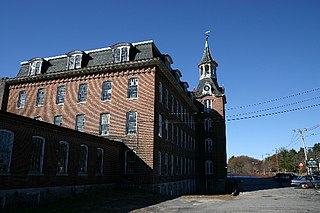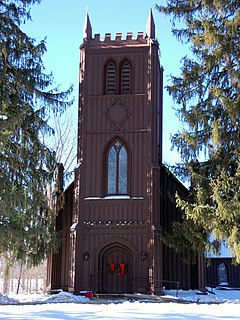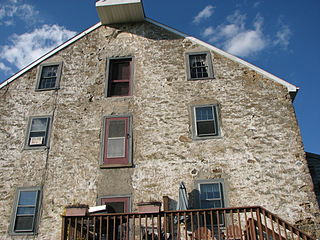
Valatie is a village with several waterfalls in Columbia County, New York, United States. The population was 1,819 at the 2010 census. The village is at the center of the town of Kinderhook on US 9.

Wakefield is a village in the town of South Kingstown, Rhode Island, United States, and the commercial center of South Kingstown. Together with the village of Peace Dale, it is treated by the U.S. Census as a component of the census-designated place identified as Wakefield-Peacedale, Rhode Island. West Kingston, another South Kingstown village, was the traditional county seat of Washington County. Since 1991, the Washington County Courthouse has been in Wakefield. The Sheriff's Office which handles corrections is also in Wakefield.

Harmony Mills, in Cohoes, New York, United States, is an industrial district that is bordered by the Mohawk River and the tracks of the former Troy and Schenectady Railroad. It was listed as Harmony Mills Historic District on the National Register of Historic Places in 1978. A portion of the district encompassing the industrial buildings and some of the housing built for millworkers was declared a National Historic Landmark in 1999. The centerpiece building, Harmony Mill No. 3 was listed on the National Register of Historic Places in 1971.

Locust Lawn is a surviving 19th-century farm complex situated on the bank of the Plattekill Creek on New York State Route 32, outside of New Paltz, Ulster County, New York.

Ashe Cottage, also known as the Ely House, is a historic Carpenter Gothic house in Demopolis, Alabama. It was built in 1832 and expanded and remodeled in the Gothic Revival style in 1858 by William Cincinnatus Ashe, a physician from North Carolina. The cottage is a 1 1⁄2-story wood-frame building, the front elevation features two semi-octagonal gabled front bays with a one-story porch inset between them. The gables and porch are trimmed with bargeboards in a design taken from Samuel Sloan's plan for "An Old English Cottage" in his 1852 publication, The Model Architect. The house is one of only about twenty remaining residential examples of Gothic Revival architecture remaining in the state. Other historic Gothic Revival residences in the area include Waldwic in Gallion and Fairhope Plantation in Uniontown. Ashe Cottage was added to the Alabama Register of Landmarks and Heritage on August 22, 1975, and to the National Register of Historic Places on 19 October 1978.

The Main Street Historic District is a small residential historic district south of the downtown area of Auburn, Maine. The fourteen houses in the district represent a cross-section of residential development during Auburn's growth between about 1825 and 1925. The district extends along Main Street, from Drummond Street south just past Elm Street, and includes a few houses on Elm and Vine Streets. The district was added to the National Register of Historic Places in 1989.

The Linwood Historic District is an industrial historic district in the Linwood village of Northbridge, Massachusetts. It is the site of the Linwood Cotton Mill and is roughly bounded by Linwood Avenue, Maple Court, and Pine Court. On June 16, 1989, it was added to the National Register of Historic Places.

The William J. Dickey House is located on Imperial Avenue in Cohoes, New York, United States. It was built for Dickey, the superintendent of a local textile mill, in 1890, by an unknown architect.

Church of St. John the Evangelist was a historic Episcopal church on Chittenden Road in Stockport, Columbia County, New York. It was completed in August, 1846 at a cost of $12,000 and consecrated by Bishop Heathcote Delancey of the Diocese of Western New York on July 3, 1847. Earlier, the Reverend Henry Townsend of the Diocese of Connecticut rode on horseback over the Berkshire Mountains to attend the original incorporation meeting on Sept. 20, 1845. St. John's was the first Episcopal church built in Columbia County, NY and its grounds bear one of two original lychgates in the county, the second being at St. Mark's Church in Philmont. St. John's was a one-story, rectangular, wood-frame building in the board-and-batten Carpenter Gothic style painted deep brown, hence its affectionate local moniker, "The Little Brown Church.". It featured a projecting center entrance tower holding a cast iron church bell, double entry doors, stained glass window and upper double vents. The main entrance, flanked by iron boot scrapers, opens to reveal a simple vestibule bearing the bell rope and a framed plaque in memory of Joseph Marshall, builder of the church, whose remains are interred beneath where the north transept was. Marshall was born in Huddersfield, England in 1773, emigrated to America in 1827, built St. John's in 1846 and died in 1848. Steep gable roofs protected the horizontal main structure containing the organ loft, nave, chancel and sanctuary. The north and south walls of the nave each contained four beautiful stained glass windows. At the building's northwest corner at right angles to the main nave was a former sacristy, which used to form the organ chamber. At the southwest corner stood the sacristy. The adjacent cemetery contains approximately 2,200 burials from 1821 to the present.

Wild's Mill Complex was among the last remaining industrial buildings in the formerly thriving milling community of Valatie, Columbia County, New York, United States. It was located southeast of the intersection between U.S. Route 9 and State Route 203. A five-story brick structure, it served as an historical landmark and its 5.5 acres (2.2 ha) lot contained the ruins of a previous mill. It was situated along the west bank of the Kinderhook Creek.

The Davenport House, also known as Sans-Souci, is an 1859 residence in New Rochelle, New York, designed by architect Alexander Jackson Davis in the Gothic Revival style. The "architecturally significant cottage and its compatible architect-designed additions represent a rare assemblage of mid-19th through early 20th century American residential design". The house was listed on the National Register of Historic Places in 1980.

Jacob Rutsen Van Rensselaer House and Mill Complex is a historic home and mill complex consisting of 14 interrelated buildings and located at Claverack in Columbia County, New York.

The William Hayden House is a private residence located at 108 West Pottawatamie Street in the city of Tecumseh in northeast Lenawee County, Michigan. It was designated as a Michigan Historic Site and added to the National Register of Historic Places on August 13, 1986.

The George Angus and Martha Ansil Beebe House is a historic house located in Provo, Utah, United States. It is listed on the National Register of Historic Places.

The John W. Day House, also known as the Day-Dittman House, is a private residential structure located at 4985 Dryden Road in Dryden Township in southern Lapeer County, Michigan, United States. It was designated as a Michigan State Historic Site on September 26, 1987 and soon after added to the National Register of Historic Places on December 17, 1987.

There are two historic mills called Warwick Mills. The older of the two is in Pennsylvania and is no longer running. The other is in New Hampshire, and is still manufacturing today.

The Timothy Bancroft House is a historic house on Bancroft Road in Harrisville, New Hampshire. Located in a rural area once known as Mosquitoville, this c. 1785 wood frame house was built by Timothy Bancroft, who operated a sawmill nearby that was one of the town's major industries for nearly a century. The house was listed on the National Register of Historic Places in 1988.

The Mill Agent's House is a historic house at Maine State Route 32 and Priest Hill Road in North Vassalboro, Maine. Built in 1851 for the manager overseeing the village's textile mill, it is a large and distinctive example of Greek Revival architecture. It was listed on the National Register of Historic Places in 1983.

The Old Red Mill and Mill House are a historic 19th-century mill building and residence on Red Mill Drive in Jericho, Vermont. The mill was built in 1856 and enlarged later in the 19th century, accommodating then state-of-the art grain rollers, and was a prominent local business. The house was built in 1859, and is a good local example of Gothic Revival architecture. The mill is now a museum property of the local Jericho Historical Society. The mill building was listed on the National Register of Historic Places in 1972; the listing was expanded to include the house in 1976.

The Newington Gilbert House is a historic house in Afton, Minnesota, United States. It was built in 1864 in what was then the separate community of Valley Creek. The house was listed on the National Register of Historic Places in 1982 for its local significance in the themes of architecture and exploration/settlement. As one of the original houses in Valley Creek, it was nominated for helping to depict one of the many small Washington County settlements that formed around a commercial venture—though one that never progressed to formal platting—and the community's two-decade preference for Greek Revival architecture. Valley Creek was later formally incorporated into Afton.























